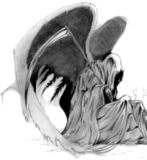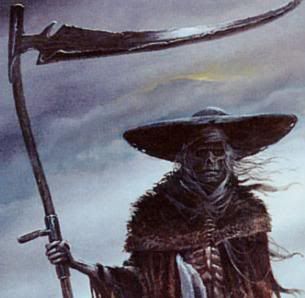
(and all of its tales)
Death as a sentient entity is a concept that has existed in many societies since the beginning of history. In English, death is often given the name the "Grim Reaper" and from the 15th century onwards came to be shown as a skeletal figure carrying a large scythe and clothed in a black cloak with a hood. It is also given the name of the Angel of Death
In some cases, the Grim Reaper is able to actually cause the victim's death, leading to tales that he can be bribed, tricked, or outwitted in order to retain one's life. Other beliefs hold that the Spectre of Death is only a psychopomp, serving only to sever the last tie from the soul to the body and guide the deceased to the next world and having no control over the fact of their death.
In many languages Death is personified in male form (English including), while in others it is perceived as a female character (for instance, in Slavic languages, e.g. in Polish).
Japanese mythology/folklore
In Kojiki, after giving birth to the fire-god Hinokagutsuchi, the goddess Izanami dies from wounds of its fire and enters the perpetual night realm called Yominokuni that the gods thereto retire. After Izanagi, her husband, failed in the attempt to reclaim her from the land of Yomi (the underworld, to which he travels and discovers his wife as not-so beautiful anymore), in a brief argument with Izanagi, she claimed to take 1000 lives every day signifying her position as the goddess of death.
Another popular death personification is Enma (Yama), also known as 閻魔王 (Enma Ou) and 閻魔大王 (Enma Daiou) meaning "King Enma", or "Great King Enma" which are direct translations of Yama Rājā. He originated as Yama in Hinduism, later became Yanluo in China, and Enma in Japan. He is from Chinese Buddhism, and before that, from India. Enma rules the underworld, which makes him similar to Hades, and he decides whether someone dead goes to heaven or to hell. A common saying parents use in Japan to scold children is that Enma will cut off their tongue in the afterlife if they lie.
There are also death gods called shinigami, which are closer to the Western tradition of the Grim Reaper. Shinigami (often plural) are common in modern Japanese arts and fiction, and essentially absent from traditional mythology.

Shinigami
Memitim
The memitim are a type of angel from biblical lore associated with the mediation over the lives of the dying. The name is derived from the ancient Hebrew word, "mĕmītǐm," and refers to angels that brought about the destruction of those whom the guardian angels no longer protected.[1] While there may be some debate among religious scholars regarding the exact nature of the memitim, it is generally accepted that, as described in the Book of Job 33:22, they are killers of some sort.Death and Satan
The angel of death, who is identified by some with Satan, immediately after his creation had a dispute with God as to the light of the Messiah (Pesiḳ. R. 161b). When Eve touched the tree of knowledge, she perceived the angel of death, and thought "Now I shall die, and God will create another wife for Adam". Adam also had a conversation with the angel of death (Böklen, "Die Verwandtschaft der Jüdisch-Christlichen mit der Parsischen Eschatologie," p. 12). The angel of death sits before the face of the dead (Jellinek, l.c. ii. 94). While Abraham was mourning for Sarah the angel appeared to him, which explains why "Abraham stood up from before his dead".Samael told Sarah that Abraham had sacrificed Isaac in spite of his wailing, and Sarah died of horror and grief. It was Moses who most often had dealings with the angel. At the rebellion of Korah, Moses saw him (Num. R. v. 7; Bacher, l.c. iii. 333; compare Sanh. 82a). It was the angel of death in the form of pestilence which snatched away 15,000 every year during the wandering in the wilderness (ib. 70). When Moses reached heaven, the angel told him something (Jellinek, l.c. i. 61).
When the angel of death came to Moses and said, "Give me thy soul," Moses called to him: "Where I sit thou hast no right to stand." And the angel retired ashamed, and reported the occurrence to God. Again, God commanded him to bring the soul of Moses. The angel went, and, not finding him, inquired of the sea, of the mountains, and of the valleys; but they knew nothing of him. Really, Moses did not die through the angel of death, but through God's kiss ("bi-neshiḳah"); i.e., God drew his soul out of his body (B. B. 17a; compare Abraham in Apocryphal and Rabbinical Literature, and parallel references in Böklen, l.c. p. 11). Legend seizes upon the story of Moses' struggle with the angel of death, and expands it at length (Tan., ed. Stettin, pp. 624 et seq.; Deut. R. ix., xi.; Grünhut, l.c. v. 102b, 169a). As Benaiah bound Ashmedai (Jew. Encyc. ii. 218a), so Moses binds the angel of death that he may bless Israel.
Solomon once noticed that the angel of death was grieved. When questioned as to the cause of his sorrow he answered: "I am requested to take your two beautiful scribes." Solomon at once charged the demons to convey his scribes to Luz, where the angel of death could not enter. When they were near the city, however, they both died. The angel laughed on the next day, whereupon Solomon asked the cause of his mirth. "Because," answered the angel, "thou didst send the youths thither, whence I was ordered to fetch them" (Suk. 53a). In the next world God will let the angel of death fight against Pharaoh, Sisera, and Sennacherib.
Nobody Knows the real image of all this creature.
there are times that you think that nobodies with you but death is always there
there is one question left to answer
the question is doomsday near????
(click the word doomsday)
0 comments:
Post a Comment